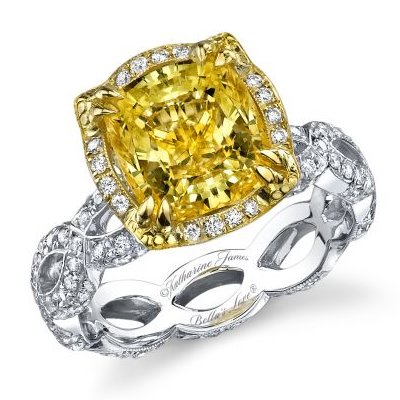
Natural yellow diamonds come in a wide variety of colors and shades, making these rare gemstones all the more special and unique. Unlike clear diamonds, which are structured of 100% carbon molecules, the colored diamonds include a second element. These diamonds attribute their unique coloring to trace amounts of nitrogen in their atomic structure. The nitrogen refracts the light in a slightly different way, resulting in a very distinct color. Yellow diamonds come in hues ranging from a deep brownish-yellow to a vibrant sunshine gold color. You can also find yellow diamonds in a soft, translucent whitish yellow hue.
4 Types of yellow diamonds
1. Canary Diamonds
Canary diamonds are the first type of yellow diamond that usually springs to mind, named after their intense, vibrant canary yellow shade. These gemstones are beautiful paired with yellow or white gold, making for some very eye-catching yellow diamond engagement rings.
2. Zimmi Yellow Diamonds
This type originates from southern Sierra Leone, and is known for its exceptionally strong dazzling yellow. Due to the unique geological conditions under which these diamonds form, Zimmi diamonds are so rare that they make up only 0.8% of all yellow diamonds on earth. The Zimmi may be the youngest type of yellow diamonds that we know about.
3. Cape Diamonds
Paler yellow diamonds are known as Cape Diamonds, because they’re found in the Cape Province in South Africa. Geologists often debate whether these enchanting small light diamonds should truly be classified as “yellow diamonds,” as they fall somewhere in between yellow and white on the D-Z color scale. This label changes nothing in terms of the cape diamonds’ exquisite beauty, but it does place them in the range of greater affordability.
4. Champagne Diamonds or Cognac Diamonds
Dark yellow diamonds are the rarest of the yellows, and they typically cost the most. Known as Champagne Diamonds or Cognac Diamonds, these precious gemstones possess an internal fire of golden light, and claim some of the biggest diamonds ever recorded. Earth’s current largest cut diamond is called Golden Jubilee, an enormous 545.65 carat Champagne Diamond owned by the royal family of Thailand. Its discovery in 1983 superseded the more famous Great Star of Africa, a 530.4 ct. Champagne Diamond found in 1908.
Color
The GIA (Gemological Institute of America) uses the D-Z scale to define the exact color of diamonds. D is the clearest and most colorless; Z is the darkest on the scale. Interesting to note, the pricing of diamonds is greatest at the two ends of the spectrum, since both absolutely clear diamonds and vibrant yellow diamonds are the most rare.
Clarity
Clarity means the absence of abrasions, inclusions, and blemishes. The GIA specifies 6 possible degrees of clarity in a diamond:
Cut
The quality of the cut determines the number of facets on the face of the diamond, and therefore has a great deal to do with its sparkle. Cut quality is measured by symmetry and polish, and graded on a scale of Excellent, Very Good, Good, and Fair.